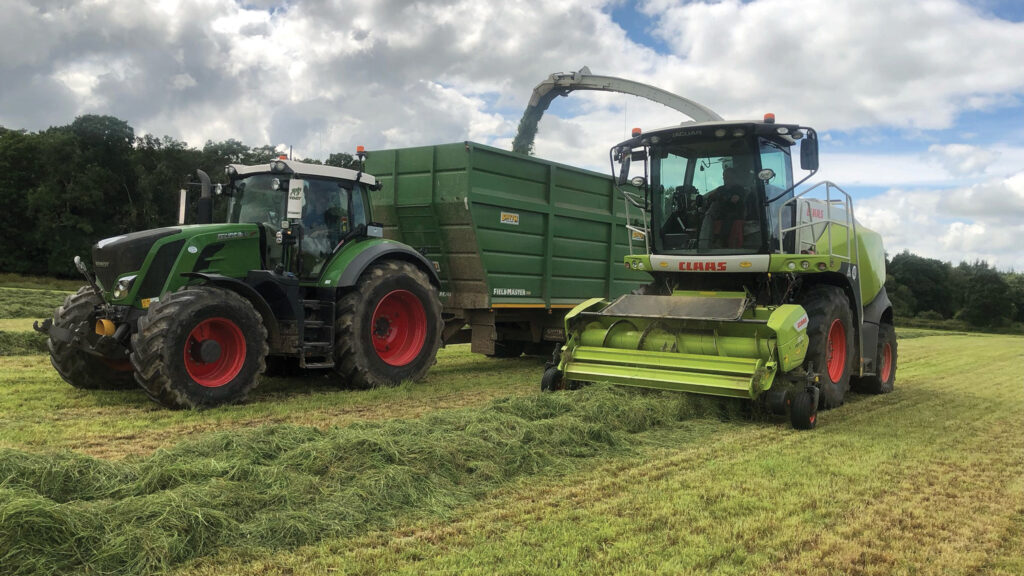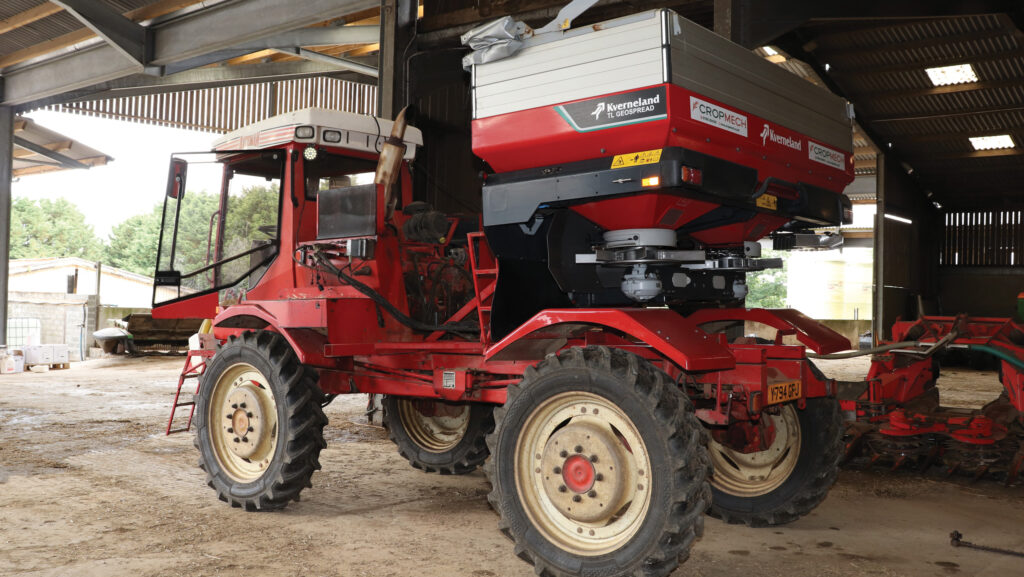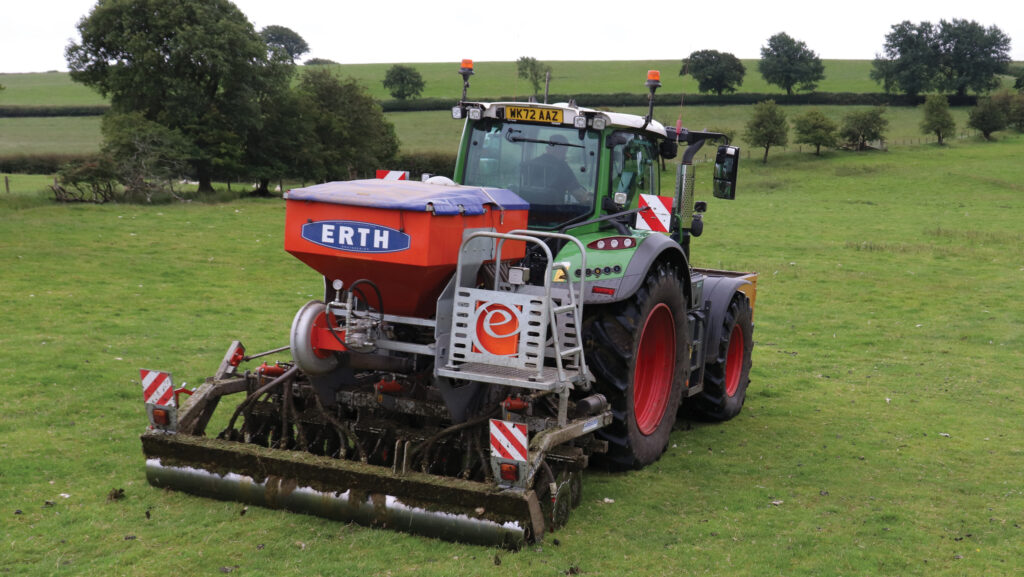Contractor Comment: Holding on to tractors until prices drop
 © Mark Stevens
© Mark Stevens Rain, rain, and more rain. No prizes as to what’s dominated the Cropmech calendar since our previous visit back in March.
“In May we ended up calling in two diggers and a high-horsepower tractor to either dig out or drag out a lime spreader, the RB35 sprayer and the big 4m combi drill,” says Elliot Stevens, who runs the Okehampton-based contracting and crop storage/processing operation with his father, Mark.
“It’s all expense and downtime that we could’ve done without.
See also: Contractor Comment: Warranty dilemmas and pricey pickups
Spring progress
A successful yet protracted maize drilling campaign was perhaps the exception, with the firm planting its planned 550ha by the end of May.
Even so, there were two to three weeks in late April/early May when the machines didn’t move.
All maize crops were sown with a new eight-row Amazone 6000-2CC precision drill, other than the 50ha that went under plastic with a four-row Samco.
“Arguably, this was a good year to have stuck with plastic, as it’s been so cold and wet. These ‘plastic’ crops are probably about a month ahead of most of the conventionally sown maize in the area,” says Elliot.
Although still popular with some Cropmech customers, the firm has seen a steady decline in the use of plastic. This is largely down to cost: £60/ha (drilling) plus £60/ha (DAP fertiliser) for conventional establishment, versus £160/ha (drilling) plus £250/ha (plastic) with the Samco.
Lime spreading was also busier than normal, with over 6,500t applied up to the end of June. But the forage harvesting area was slightly down, largely because of the weather.

Elliot Stevens © Andrew Faulkner
Business facts: Cropmech, Huish Barton, Merton, Okehampton, Devon
- Main services Maize and grass silage (1,820ha), combining (1,100ha), spraying (14,000ha), square baling (15,000 120x70cm bales), lime spreading (10,000t), drilling (2,000ha), straw processing (650 hours)
- Additional services 800ha farming (share, contract, FBTs); 16-strong haulage fleet; telehandler hire; grain storage/marketing (60,000t); grain sampler sales
- Staff 12 full-time (farming), plus another 26 (other parts of the business)
Balers and sprayers
A new MF2234 baler arrived in April, joining an existing 10-year-old MF2260. Together, they had pumped out only 2,600 bales of silage, haylage and hay by the end of June.
“This is a long way behind what we’ve usually baled at this point, again mainly down to the lack of weather to make the typical June hay in this area,” says Elliot.
“Our original plan was to sell the older 2260, but it was only worth £25,000. Last year, we’d shelled out £20,000 sorting various timing issues and general wear and tear, so we decided to hang onto it, knowing there’d be enough demand for two machines if we wanted the work.”
It proved a good decision for another reason. The new 2234 spent most of its first four weeks laid up while Big Bale South attempted to resolve a bale length issue, so the 2260 saw plenty of unexpected early-season action.
“Frustrating doesn’t come close. I was tempted to send the 2234 back. I’d got a £25,000 baler doing all the work and a £140,000 baler parked up in the shed,” says Elliot.
The 2234 culprit turned out to be a faulty pre-chamber sensor, which was failing to reliably register when the required seven flakes had been formed to prompt a knotting cycle. As a result, bale length was either 0.5m too long or too short.
“It’s one of those situations where you question the value of modern technology. We wouldn’t have had this problem with the old baler’s mechanical bale length system,” Elliot says.
“Big Bale seems to have sorted the issue now, but I can’t bring myself to tot up the time we’ve lost.”
The only other breakdown of note was to the second string sprayer, an eight-year-old Bateman 3,000-litre/24m RB26. The main machine is a 4,000-litre/24m RB35, with a 23-year-old 2,500-litre/24m RB16 kept as back-up.
On average, the RB16 only clocks an annual 800ha, but this year it’s on course to at least double that figure while the RB26 remains out of action.
“The RB26’s Deere engine wouldn’t regenerate and kept going into limp mode. So, on Bateman’s advice, we hauled the sprayer on one of our own trucks up to G Engineering, an engine specialist based in Suffolk,” says Elliot.
“Bateman, to be fair, has been excellent, even helping us out with a back-load to reduce the transport cost.”

Bateman RB16 © Andrew Faulkner
Planned replacements
New machine prices are unsustainably high, according to Elliot. So much so that he’s stretching his standard replacement timing, convinced that under-pressure dealers will have to become more competitive.
He has quotes for sprayers, tractors and telehandlers but won’t be signing off on them just yet.
Top of the debate list is whether to upgrade the 9,000-hour 24m Bateman RB26 to a new 36m RB35, and, at the same time, extend the existing RB35’s 24m boom to 36m.
With the RB26 valued at £40,000 and the new machine and boom extension coming in at around £300,000, the cost-to-change is about £28/hour. “That figure needs trimming,” says Elliot.
The upside is an increase in Cropmech’s spraying output, while the 36m booms would still be able to spray at 24m for those customers who prefer to stay on the narrower bouts.
But then there’s the countering downside of shorter weather windows for applying solid fertiliser to wider widths, or paying a premium for a more spreadable product for areas not using liquid fertiliser.
Further complicating matters is Cropmech’s 200ha arable unit, 150 miles away, near Swindon.
Currently, the old 24m RB16 will often stay at this site for the spraying season, whereas the farm’s average field size and topography would suit 36m.
So, how will Swindon fit in with any new sprayer and fertiliser regime? All questions to ponder.
On the tractor front, again it’s a time for mulling the options, one of which is to part-exchange an older Fendt 724 for a higher horsepower tractor to handle the second baler and a second 4m drill.
“We’ve demonstrated a New Holland and John Deere so far, but at this point we’re unsure in which direction to go.”
No other tractor replacements are planned. Traditional policy has been to take the Fendt 724s to 5,000-6,000 hours and then chop them in at a cost-to-change of £14/hour.
But, given the recent manufacturer price hikes, this target figure is proving tougher to achieve.
As for telehandlers, a 5.5t/9m Kramer KT559 has recently arrived in place of a similarly sized Merlo P55.9-CS.
The Kramer represents something of a departure for Cropmech, whose handler fleet is still dominated by Merlos.
“So far, we’ve been very impressed with the Kramer, despite the hassle of having to change the brackets on our 3.5t grain bucket and 10m pusher.
“More important, though, will be how the machine is performing in five years’ time,” says Elliot.
SFI work
As predicted, the 3m Erth overseeder has been busy stitching herbal ley seed at 12-13kg/ha into permanent grassland.
In the first half of 2024 the Erth seeder established more than 200ha, and Elliot expects this area to increase, although not dramatically.
With a payment of nearly £400/ha, the Sustainable Farming Incentive (SFI) option of establishing herbal leys is proving very popular with grass farmers in the area, and there has also been a small increase in the amount of winter bird food sown by Cropmech’s 3m power harrow drills.
“In general, landowners down here have been putting small percentages of their land into SFI rather than whole farms. For us, the work is useful extra income, but certainly not a game changer.”
Other plans
A recent reminder of the fickle nature of contracting was the pre-harvest decline in Cropmech’s straw-processing business with a Hay Buster H-1130.
“Demand for processing literally dropped off a cliff, largely down to the straw price hitting £165/t and some customers simply being unable to get hold of supplies.”
Looking to reduce the Hay Buster’s reliance on straw work, Cropmech plans to add maize, wheat and straights milling capability by fitting a Grainbuster Roto-Flow from Tub Grinding Services South West. Cost of the mod is expected to be about £11,500.
With an increase in processing work, along with other plans in the pipeline, Elliot remains very optimistic about the future.
“Although farming is tough at the moment, there’s a real feeling of change in the industry. Change brings opportunities, and that’s exciting.”

Fendt 724 © Andrew Faulkner
Kit list
- Fendt 828, 724 (x5), 415, New Holland T7.210, T6.180
- Combines New Holland CR9.90, Claas Lexion 750TT and Lexion 550
- Forager Claas Jaguar 860
- Handlers JCB Loadall 536-60, mixed hire fleet of 7-26m machines (x15 –Merlo, Dieci and Kramer)
- Sprayers Bateman RB35 (24m/4,000-litre), RB26 (24m/3,000-litre), RB16 (24m/2,500-litre)
- Drills 3m (x2) and 4m combination drills, Erth overseeder, 4m Kuhn SD4000 direct drill, 6m Kuhn air seeder, four-row Samco maize drill (plastic), eight-row Amazone Precea 6000-2CC maize drill (with fert)
- Main other kit MF2234 baler, MF2260 baler, rakes (x2), 9m triple mower, lime spreaders (x2), straw processor, ploughs (x3), fertiliser spreader, slurry tankers (x2) and assorted trailers

